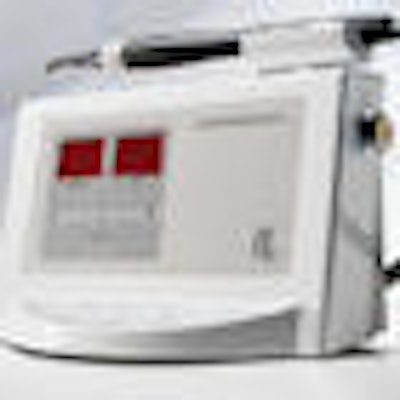
While fluorescence-based caries detection devices have been shown to offer clinical decision-making support, visual inspection should continue to be the primary detection method for occlusal caries, according to a new study in the Journal of the American Dental Association.
Visual examination and radiographic imaging are the two most common methods of caries detection, but both exhibit high specificity and low sensitivity for occlusal caries, noted the study authors, a team of university researchers from Brazil and Switzerland (JADA, April 2012, Vol. 143:4, pp. 339-350).
These challenges have prompted the development of additional tools and methods to improve caries detection and quantify early lesions, including laser-fluorescence-based devices like the Diagnodent (KaVo) and VistaProof (Durr Dental; sold in the U.S. by Air Techniques as Spectra). But there has been ongoing discussion and debate over the effectiveness of these devices compared to visual examination using the International Caries Detection and Assessment System (ICDAS) and radiography.
For example, while some studies have reported good performance of the Diagnodent and Diagnodent Pen in detecting occlusal caries, researchers have also observed a large number of false-positive results using these tools, which limits their use as a principal diagnostic tool, according to the JADA study authors.
“It is getting more important to consider quantitative methods as an adjunct to visual examination and radiographs.”
— Anahita Jablonski-Momeni,
professor, Philipps-University of
Marburg Dental School
These issues prompted them to conduct an in vivo study to determine clinical cutoffs for these three laser fluorescence caries detectors and to evaluate their clinical performance in detecting occlusal caries in permanent teeth.
"The clinical performance of fluorescence-based caries detection methods is related to the cutoffs used in clinical practice, which enable dental professionals to provide patients with the appropriate treatment," the study authors wrote. "The importance of cutoffs means that a small change in the reading could be the difference between performing an operative intervention or not, which is a dangerous aspect of these devices if they are used throughout the decision-making process."
Histologic comparison
For this study the researchers recruited 88 patients (ages 18-35) from the department of oral and maxillofacial surgery at the School of Dentistry of Araraquara, Universidade Estadual Paulista. All study participants had at least one posterior tooth scheduled for extraction because of periodontal disease or for orthodontic reasons, independent of its occlusal surface condition. A total of 105 posterior permanent teeth were included in the study: 42 maxillary molars, 23 mandibular molars, 24 maxillary premolars, and 16 mandibular premolars.
A trained examiner conducted a visual examination of each tooth and recorded the caries status using standard ICDAS criteria. Bitewing radiographs were then taken and analyzed for caries.
The examiner then assessed each occlusal surface using the Diagnodent, Diagnodent Pen, and VistaProof, according to the manufacturers' instructions. To avoid giving the examiner any idea of a lesion's score during the process, the audio option on these devices remained off. The designated teeth were then extracted and examined histologically.
In order to assess the performance of these devices, the researchers used both the manufacturers' proposed clinical cutoffs and their own set of optimal clinical cutoffs, which they determined by the cutoff at which the sum of sensitivity and specificity values was maximal in the receiver operating characteristic curve analysis at each of four histologic thresholds (D1, D2, D3, D4).
|
|
> 2 |
When the researchers compared the histologic findings to the other methods, they found that ICDAS correctly indicated 48 enamel carious lesions (66%), whereas the Diagnodent correctly indicated 40 (55%) and the Diagnodent Pen correctly identified 39 (53%). In contrast, the VistaProof correctly indicated 10 (14%) and the bitewing radiographs correctly indicated 11 (15%). For dentin caries, the Diagnodent correctly indicated 22 (82%), the Diagnodent Pen and VistaProof correctly indicated 23 (85%), ICDAS correctly indicated only 14 (52%), and the bitewing radiographs only 12 (44%).
Optimal cutoffs
It is interesting to note that the Diagnodent and the Diagnodent Pen helped detect more lesions correctly with the use of the optimal cutoffs than with the cutoffs proposed by the manufacturer. In addition, the optimal cutoffs provided a "great balance" between specificity and sensitivity, which can help improve their performance, the researchers wrote.
"Manufacturers propose different cutoffs than those obtained in in vitro and in vivo studies, which may explain the variety of results found in the literature, which can confound clinicians who are deciding the best treatment," the study authors noted. "Considering that there are differences between the cutoffs, using those proposed by the manufacturer can affect the interpretation of the ... measurements and, consequently, lead to overestimation of carious lesion detection and overtreatment."
Historically, the leading issue of the Diagnodent device appears to be a lack of agreement regarding cutoff values, noted Gustavo M. S. Oliveira, DDS, MS, assistant professor in the department of general dentistry and oral medicine at the University of Louisville.
"As pointed out by the authors and also shown in other studies, in vitro and in vivo cutoff findings do not necessarily correlates with the values proposed by the manufacturer," Dr. Oliveira told DrBicuspid.com. "This also seems to be true for the Diagnodent Pen. Another evidence of the issue is the poor correlation between Diagnodent readings with extent of carious tooth structure. In fact, a single use of these devices may not render the full story behind the carious lesions, since it only generates a moment's picture of the disease, which may not be active anymore or even have regressed through remineralization."
ICDAS rules!
In the long run, while the Diagnodent and Diagnodent Pen demonstrated good performance in helping detect occlusal caries in vivo, occlusal caries detection should be based primarily on visual inspection, the study authors emphasized.
"Although fluorescence-based methods seem to be suitable for detecting occlusal caries in a preselected population of specific areas on occlusal surfaces in permanent teeth, they should be used to provide a second opinion in clinical practice," they concluded.
Studies on performance and validation of caries-detection methods are usually assessed in vitro using extracted teeth due to the common gold standard of histology, noted Anahita Jablonski-Momeni, professor in the department of pediatric and community dentistry at Philipps-University of Marburg Dental School, who has conducted similar research. Using an in vivo approach bypasses some of the problems encountered in in vitro studies, she added.
"In recent years, the requirements for precise assessment and confident diagnosis have increased, since early detection of carious lesions is now being given a high priority," Dr. Jablonski-Momeni stated in an email to DrBicuspid.com. "At the same time, detection tools for dentists have become more numerous and various methods are constantly being invented or further developed. It is getting more important to consider quantitative methods as an adjunct to visual examination and radiographs whenever indicated."
Dr. Oliveira agreed.
"Judicious visual inspection is a reliable method for occlusal caries detection and should be routinely used by clinicians as a primary influence on the decision-making process, together with a thoroughly constructed caries risk assessment," he stated. "Fluorescence-based devices should not be used as a surrogate method for occlusal caries detection, but rather as an additional source of information."
Researchers' optimal clinical cutoffs
|
33-99 | 1.4-5 |



















